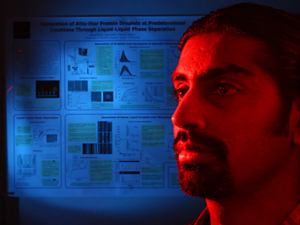The government’s task of safeguarding the nation hinges in part on its ability to quickly and accurately detect toxic biological agents. Graduate student Mrinal Shah’s recent breakthrough in liquid-liquid phase separation may be the first integral step along the road to developing a protein-based biosensor that would do just that.
Shah’s research makes use of the proteins needed in biosensors, and it accurately controlled the nucleation of that protein. The next step, says Shah, will be to tag the protein molecule onto the micro-area electrode. “That will be a challenge, but we already have several promising strategies in mind,” says Shah, a native of India pursuing a doctorate degree in chemical engineering at the UH Cullen College of Engineering.
If such a biosensing chip is successfully developed, its potential uses are manifold and urgently needed. “There could be several applications for such a chip that are significant right now,” Shah says. “If there is biological warfare somewhere and you put this chip into that environment, you would know exactly what is in that environment, and safety precautions could be taken. That’s the ultimate achievement that every scientist working in protein chips dreams about.”
Shah is working under the direction of chemical engineering professor Peter Vekilov, a world-renowned expert in the field of nucleation. “It was a difficult project,” explained Vekilov, “because we were hoping that one of two approaches would work, and neither of them did. We tried electrophoresis and dielectrophoresis and neither worked. But Mrinal kept working, kept trying new things, and finally developed his own method. What we discovered is that the solution has a time-dependent non-uniform electric field, and this is what causes the nucleation.”
Shah said there are a number of other applications for the chip including combating Mad Cow disease and Anthrax.
“Nobody knows what kind of diseases these are; they are still in the process of studying these diseases and looking at the effect of them on human proteins,” Shah said. “If you put a chip with several different proteins into an environment or solutions which has some kind of organism, it would interact with whatever the solution had in it, and we would be able to significantly say that the solution has all the compliments of X, Y and Z because of the tagging of the protein.”
While these methods could prove useful in the early detection of diseases such as Parkinson’s, Alzheimer’s and sickle cell anemia, Shah said he is not searching for any cures.
“We’re not finding cures ourselves but we are finding the mechanisms that follow the formations of these fibers,” Shah said. “Once you know the mechanism then we can also know by what methods we can reduce the rate of its formation. The physics behind the mechanisms is much more interesting to us.”
Biosensing chips are already in use but for studies such as the quality control of water or checking glucose levels. Shah’s involvement in the biosensing application began with his initial interest in protein nucleation, which occurs with diseases such as Parkinson’s, Sickle Cell Anemia, and Alzheimer’s.
“These are all protein nucleating diseases,” Shah said. “What basically happens is the protein is happy inside the body, and suddenly, something happens and it just starts nucleating. The protein misfolds, denatures and begins to aggregate together forming into the disease.”
Though it was not his original area of study, Shah found that control over nucleation is essential to the creation of biosensors.
“The initial part of the project was to study the kinetics and the thermodynamics involved to better understand what mechanisms govern the phase separation of tiny droplets of protein solution,” Shah said. “While working with that we came up with the idea that we could have a new potential way of making biosensors which would be fast and easy.”
Recently, Shah presented his research at the Keck Annual Research Conference in Clear Lake and received the second place award. The Keck Center, designed to unite “modern biological, physical and computational sciences to address key problems in biology and biomedicine” is more than a decade old and began with a $5 million grant from the W. M. Keck Foundation.
